Business Environment Analysis Report: Marks & Spencer
VerifiedAdded on 2023/06/08
|21
|5040
|143
Report
AI Summary
This report provides a comprehensive analysis of the business environment, focusing on organizational types, functions, and structures, with a specific emphasis on Marks & Spencer. The report begins by defining different types of companies, including private, public, and voluntary organizations, and explores their scopes and legal structures. It then delves into the size and scope of various organizations, using Marks & Spencer, the National Health Service (NHS), and Oxfam as examples. The report examines the interrelationship between organizational functions, such as finance, marketing, human resources, and IT, and their association with business objectives. Furthermore, it analyzes the positive and negative factors impacting the macro environment of business operations and conducts internal and external analyses to determine strengths and weaknesses. Finally, the report discusses how these strengths and weaknesses correlate with external macro factors, providing a detailed and insightful examination of the business environment. The report uses Marks & Spencer as a case study, evaluating its performance within the context of the broader business environment.
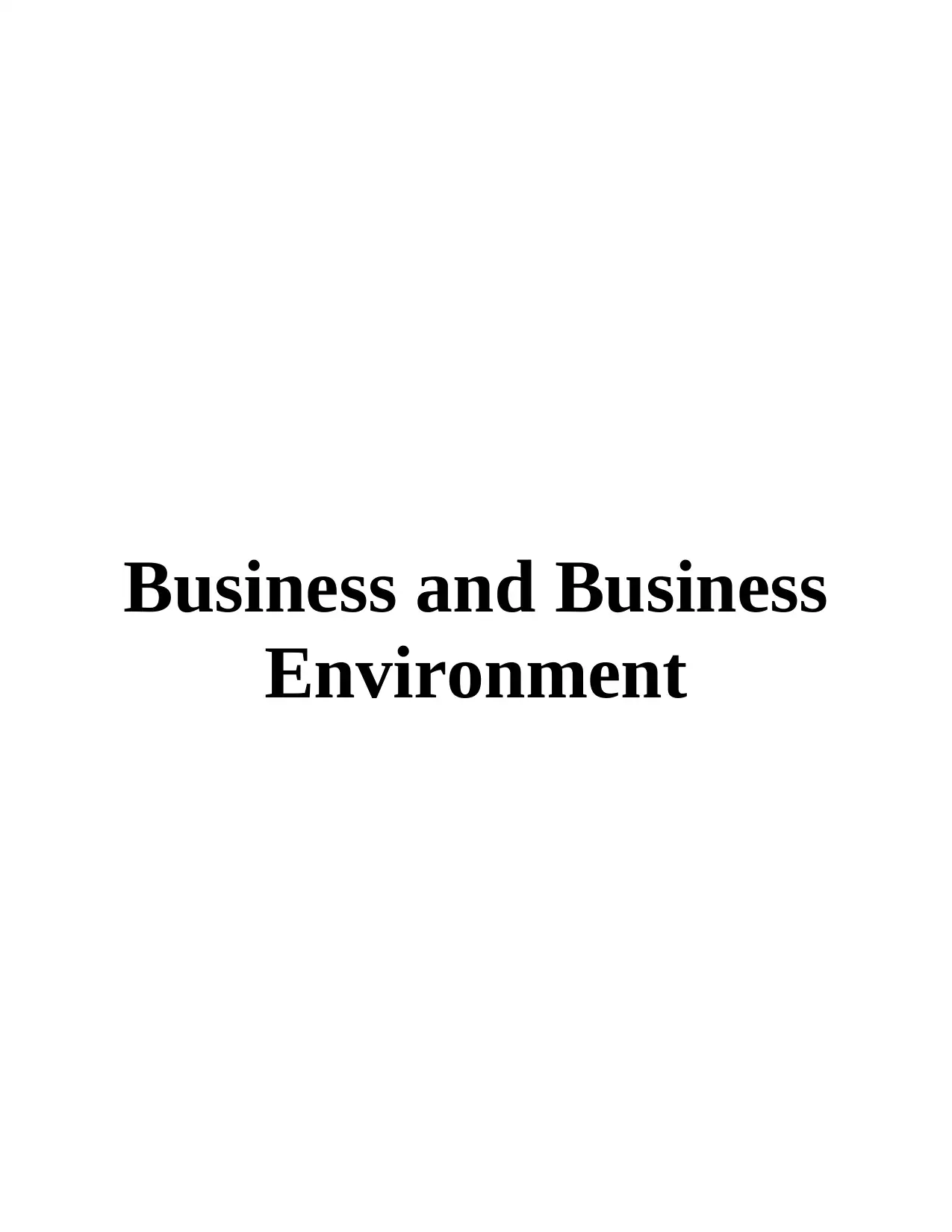
Business and Business
Environment
Environment
Paraphrase This Document
Need a fresh take? Get an instant paraphrase of this document with our AI Paraphraser
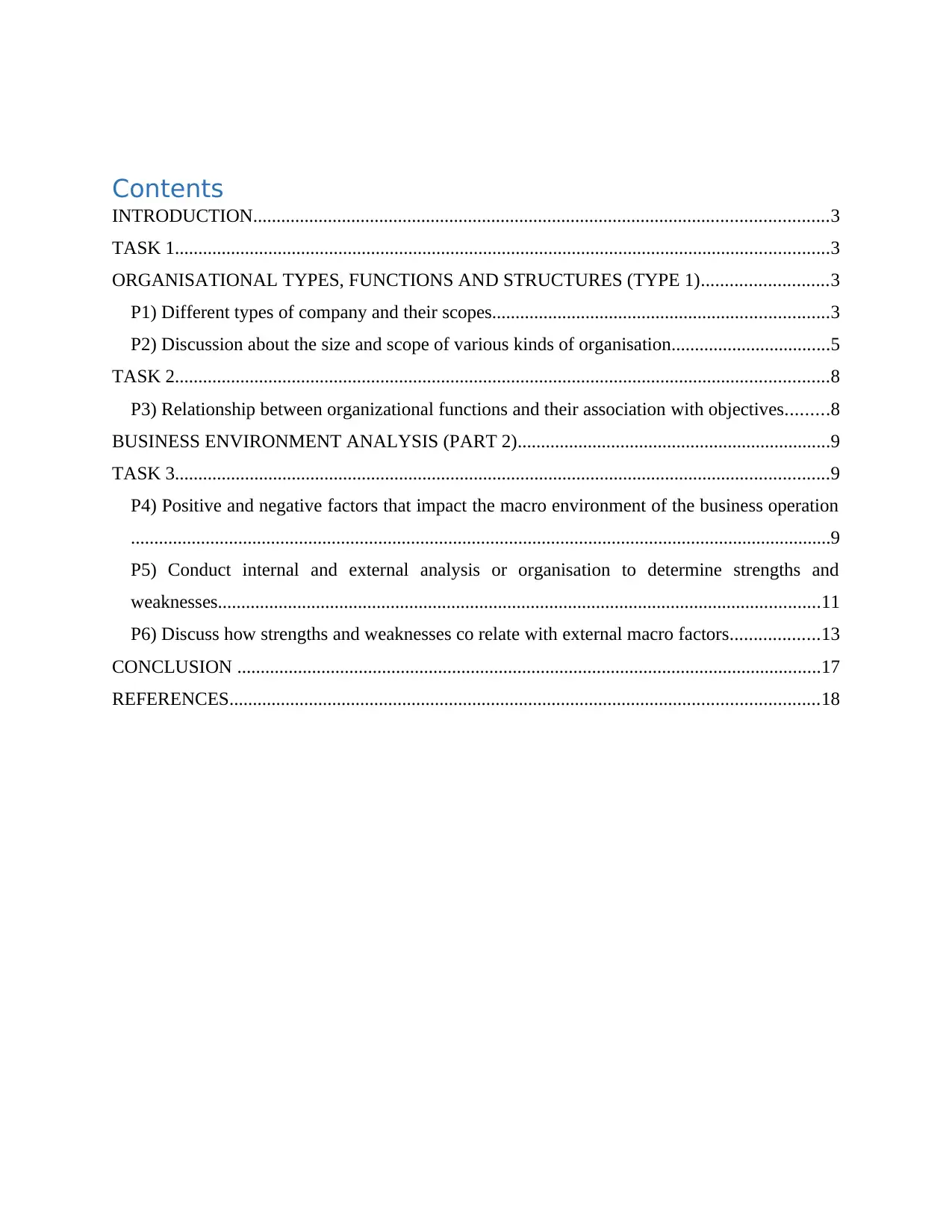
Contents
INTRODUCTION...........................................................................................................................3
TASK 1............................................................................................................................................3
ORGANISATIONAL TYPES, FUNCTIONS AND STRUCTURES (TYPE 1)...........................3
P1) Different types of company and their scopes........................................................................3
P2) Discussion about the size and scope of various kinds of organisation..................................5
TASK 2............................................................................................................................................8
P3) Relationship between organizational functions and their association with objectives.........8
BUSINESS ENVIRONMENT ANALYSIS (PART 2)...................................................................9
TASK 3............................................................................................................................................9
P4) Positive and negative factors that impact the macro environment of the business operation
......................................................................................................................................................9
P5) Conduct internal and external analysis or organisation to determine strengths and
weaknesses.................................................................................................................................11
P6) Discuss how strengths and weaknesses co relate with external macro factors...................13
CONCLUSION .............................................................................................................................17
REFERENCES..............................................................................................................................18
INTRODUCTION...........................................................................................................................3
TASK 1............................................................................................................................................3
ORGANISATIONAL TYPES, FUNCTIONS AND STRUCTURES (TYPE 1)...........................3
P1) Different types of company and their scopes........................................................................3
P2) Discussion about the size and scope of various kinds of organisation..................................5
TASK 2............................................................................................................................................8
P3) Relationship between organizational functions and their association with objectives.........8
BUSINESS ENVIRONMENT ANALYSIS (PART 2)...................................................................9
TASK 3............................................................................................................................................9
P4) Positive and negative factors that impact the macro environment of the business operation
......................................................................................................................................................9
P5) Conduct internal and external analysis or organisation to determine strengths and
weaknesses.................................................................................................................................11
P6) Discuss how strengths and weaknesses co relate with external macro factors...................13
CONCLUSION .............................................................................................................................17
REFERENCES..............................................................................................................................18

⊘ This is a preview!⊘
Do you want full access?
Subscribe today to unlock all pages.

Trusted by 1+ million students worldwide
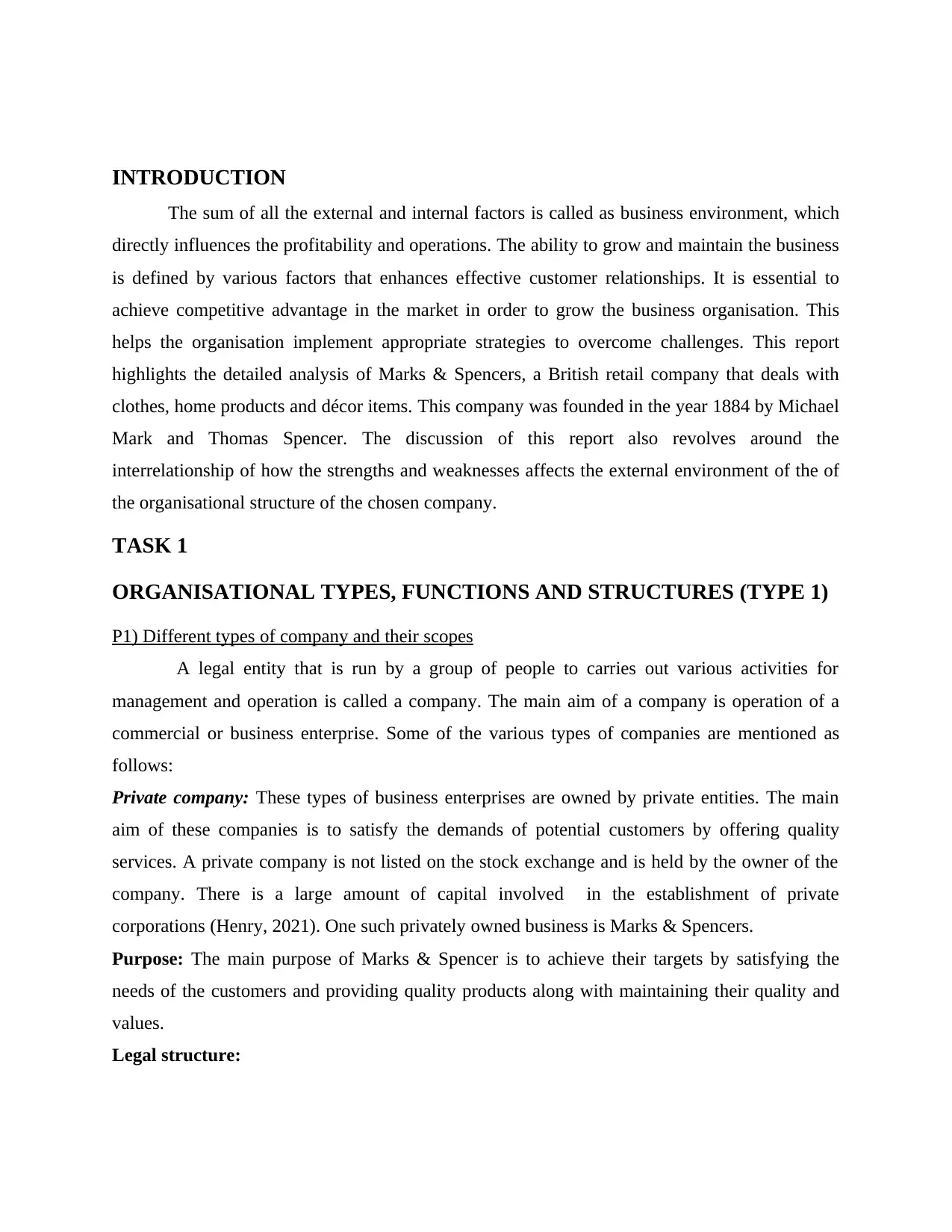
INTRODUCTION
The sum of all the external and internal factors is called as business environment, which
directly influences the profitability and operations. The ability to grow and maintain the business
is defined by various factors that enhances effective customer relationships. It is essential to
achieve competitive advantage in the market in order to grow the business organisation. This
helps the organisation implement appropriate strategies to overcome challenges. This report
highlights the detailed analysis of Marks & Spencers, a British retail company that deals with
clothes, home products and décor items. This company was founded in the year 1884 by Michael
Mark and Thomas Spencer. The discussion of this report also revolves around the
interrelationship of how the strengths and weaknesses affects the external environment of the of
the organisational structure of the chosen company.
TASK 1
ORGANISATIONAL TYPES, FUNCTIONS AND STRUCTURES (TYPE 1)
P1) Different types of company and their scopes
A legal entity that is run by a group of people to carries out various activities for
management and operation is called a company. The main aim of a company is operation of a
commercial or business enterprise. Some of the various types of companies are mentioned as
follows:
Private company: These types of business enterprises are owned by private entities. The main
aim of these companies is to satisfy the demands of potential customers by offering quality
services. A private company is not listed on the stock exchange and is held by the owner of the
company. There is a large amount of capital involved in the establishment of private
corporations (Henry, 2021). One such privately owned business is Marks & Spencers.
Purpose: The main purpose of Marks & Spencer is to achieve their targets by satisfying the
needs of the customers and providing quality products along with maintaining their quality and
values.
Legal structure:
The sum of all the external and internal factors is called as business environment, which
directly influences the profitability and operations. The ability to grow and maintain the business
is defined by various factors that enhances effective customer relationships. It is essential to
achieve competitive advantage in the market in order to grow the business organisation. This
helps the organisation implement appropriate strategies to overcome challenges. This report
highlights the detailed analysis of Marks & Spencers, a British retail company that deals with
clothes, home products and décor items. This company was founded in the year 1884 by Michael
Mark and Thomas Spencer. The discussion of this report also revolves around the
interrelationship of how the strengths and weaknesses affects the external environment of the of
the organisational structure of the chosen company.
TASK 1
ORGANISATIONAL TYPES, FUNCTIONS AND STRUCTURES (TYPE 1)
P1) Different types of company and their scopes
A legal entity that is run by a group of people to carries out various activities for
management and operation is called a company. The main aim of a company is operation of a
commercial or business enterprise. Some of the various types of companies are mentioned as
follows:
Private company: These types of business enterprises are owned by private entities. The main
aim of these companies is to satisfy the demands of potential customers by offering quality
services. A private company is not listed on the stock exchange and is held by the owner of the
company. There is a large amount of capital involved in the establishment of private
corporations (Henry, 2021). One such privately owned business is Marks & Spencers.
Purpose: The main purpose of Marks & Spencer is to achieve their targets by satisfying the
needs of the customers and providing quality products along with maintaining their quality and
values.
Legal structure:
Paraphrase This Document
Need a fresh take? Get an instant paraphrase of this document with our AI Paraphraser
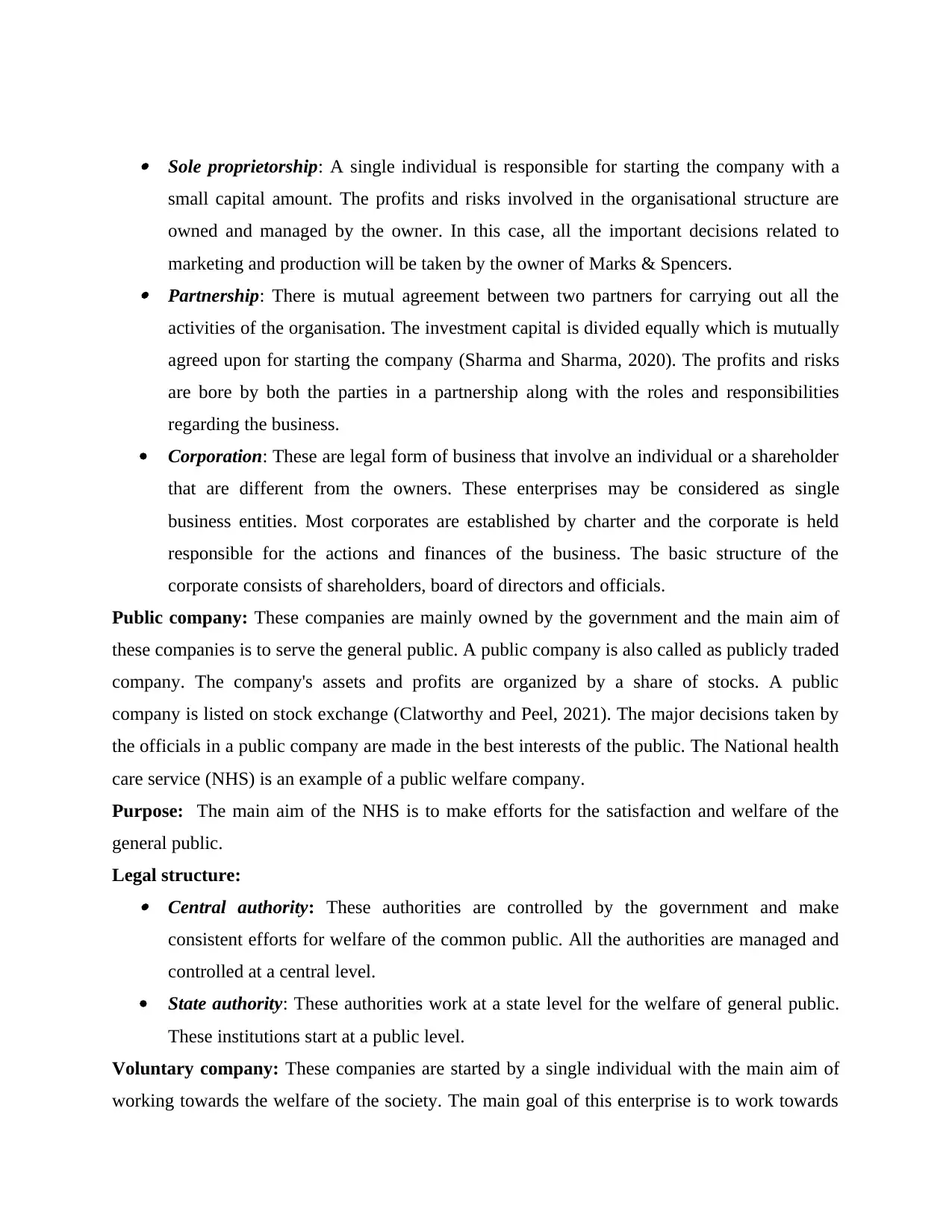
Sole proprietorship: A single individual is responsible for starting the company with a
small capital amount. The profits and risks involved in the organisational structure are
owned and managed by the owner. In this case, all the important decisions related to
marketing and production will be taken by the owner of Marks & Spencers. Partnership: There is mutual agreement between two partners for carrying out all the
activities of the organisation. The investment capital is divided equally which is mutually
agreed upon for starting the company (Sharma and Sharma, 2020). The profits and risks
are bore by both the parties in a partnership along with the roles and responsibilities
regarding the business.
Corporation: These are legal form of business that involve an individual or a shareholder
that are different from the owners. These enterprises may be considered as single
business entities. Most corporates are established by charter and the corporate is held
responsible for the actions and finances of the business. The basic structure of the
corporate consists of shareholders, board of directors and officials.
Public company: These companies are mainly owned by the government and the main aim of
these companies is to serve the general public. A public company is also called as publicly traded
company. The company's assets and profits are organized by a share of stocks. A public
company is listed on stock exchange (Clatworthy and Peel, 2021). The major decisions taken by
the officials in a public company are made in the best interests of the public. The National health
care service (NHS) is an example of a public welfare company.
Purpose: The main aim of the NHS is to make efforts for the satisfaction and welfare of the
general public.
Legal structure: Central authority: These authorities are controlled by the government and make
consistent efforts for welfare of the common public. All the authorities are managed and
controlled at a central level.
State authority: These authorities work at a state level for the welfare of general public.
These institutions start at a public level.
Voluntary company: These companies are started by a single individual with the main aim of
working towards the welfare of the society. The main goal of this enterprise is to work towards
small capital amount. The profits and risks involved in the organisational structure are
owned and managed by the owner. In this case, all the important decisions related to
marketing and production will be taken by the owner of Marks & Spencers. Partnership: There is mutual agreement between two partners for carrying out all the
activities of the organisation. The investment capital is divided equally which is mutually
agreed upon for starting the company (Sharma and Sharma, 2020). The profits and risks
are bore by both the parties in a partnership along with the roles and responsibilities
regarding the business.
Corporation: These are legal form of business that involve an individual or a shareholder
that are different from the owners. These enterprises may be considered as single
business entities. Most corporates are established by charter and the corporate is held
responsible for the actions and finances of the business. The basic structure of the
corporate consists of shareholders, board of directors and officials.
Public company: These companies are mainly owned by the government and the main aim of
these companies is to serve the general public. A public company is also called as publicly traded
company. The company's assets and profits are organized by a share of stocks. A public
company is listed on stock exchange (Clatworthy and Peel, 2021). The major decisions taken by
the officials in a public company are made in the best interests of the public. The National health
care service (NHS) is an example of a public welfare company.
Purpose: The main aim of the NHS is to make efforts for the satisfaction and welfare of the
general public.
Legal structure: Central authority: These authorities are controlled by the government and make
consistent efforts for welfare of the common public. All the authorities are managed and
controlled at a central level.
State authority: These authorities work at a state level for the welfare of general public.
These institutions start at a public level.
Voluntary company: These companies are started by a single individual with the main aim of
working towards the welfare of the society. The main goal of this enterprise is to work towards
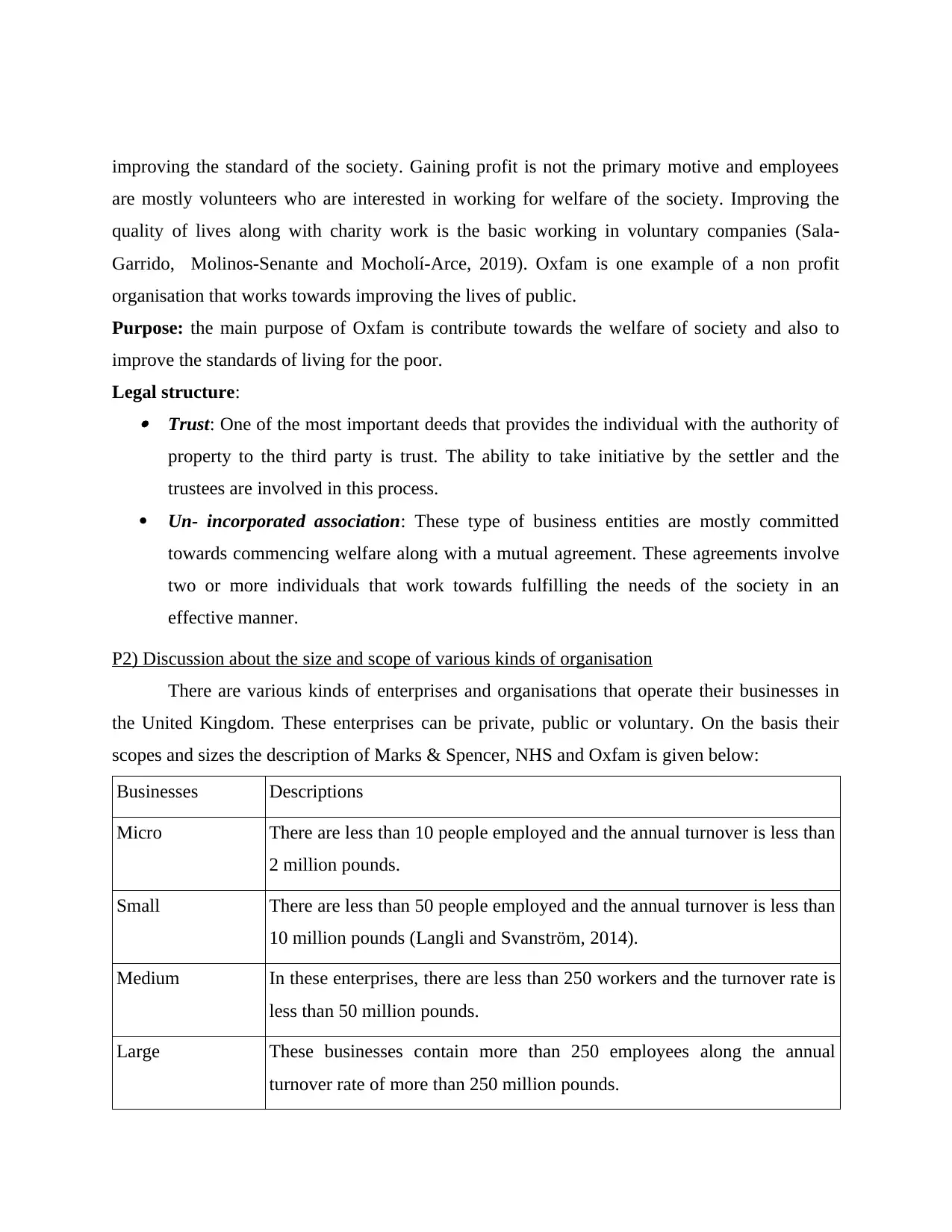
improving the standard of the society. Gaining profit is not the primary motive and employees
are mostly volunteers who are interested in working for welfare of the society. Improving the
quality of lives along with charity work is the basic working in voluntary companies (Sala-
Garrido, Molinos-Senante and Mocholí-Arce, 2019). Oxfam is one example of a non profit
organisation that works towards improving the lives of public.
Purpose: the main purpose of Oxfam is contribute towards the welfare of society and also to
improve the standards of living for the poor.
Legal structure: Trust: One of the most important deeds that provides the individual with the authority of
property to the third party is trust. The ability to take initiative by the settler and the
trustees are involved in this process.
Un- incorporated association: These type of business entities are mostly committed
towards commencing welfare along with a mutual agreement. These agreements involve
two or more individuals that work towards fulfilling the needs of the society in an
effective manner.
P2) Discussion about the size and scope of various kinds of organisation
There are various kinds of enterprises and organisations that operate their businesses in
the United Kingdom. These enterprises can be private, public or voluntary. On the basis their
scopes and sizes the description of Marks & Spencer, NHS and Oxfam is given below:
Businesses Descriptions
Micro There are less than 10 people employed and the annual turnover is less than
2 million pounds.
Small There are less than 50 people employed and the annual turnover is less than
10 million pounds (Langli and Svanström, 2014).
Medium In these enterprises, there are less than 250 workers and the turnover rate is
less than 50 million pounds.
Large These businesses contain more than 250 employees along the annual
turnover rate of more than 250 million pounds.
are mostly volunteers who are interested in working for welfare of the society. Improving the
quality of lives along with charity work is the basic working in voluntary companies (Sala-
Garrido, Molinos-Senante and Mocholí-Arce, 2019). Oxfam is one example of a non profit
organisation that works towards improving the lives of public.
Purpose: the main purpose of Oxfam is contribute towards the welfare of society and also to
improve the standards of living for the poor.
Legal structure: Trust: One of the most important deeds that provides the individual with the authority of
property to the third party is trust. The ability to take initiative by the settler and the
trustees are involved in this process.
Un- incorporated association: These type of business entities are mostly committed
towards commencing welfare along with a mutual agreement. These agreements involve
two or more individuals that work towards fulfilling the needs of the society in an
effective manner.
P2) Discussion about the size and scope of various kinds of organisation
There are various kinds of enterprises and organisations that operate their businesses in
the United Kingdom. These enterprises can be private, public or voluntary. On the basis their
scopes and sizes the description of Marks & Spencer, NHS and Oxfam is given below:
Businesses Descriptions
Micro There are less than 10 people employed and the annual turnover is less than
2 million pounds.
Small There are less than 50 people employed and the annual turnover is less than
10 million pounds (Langli and Svanström, 2014).
Medium In these enterprises, there are less than 250 workers and the turnover rate is
less than 50 million pounds.
Large These businesses contain more than 250 employees along the annual
turnover rate of more than 250 million pounds.
⊘ This is a preview!⊘
Do you want full access?
Subscribe today to unlock all pages.

Trusted by 1+ million students worldwide
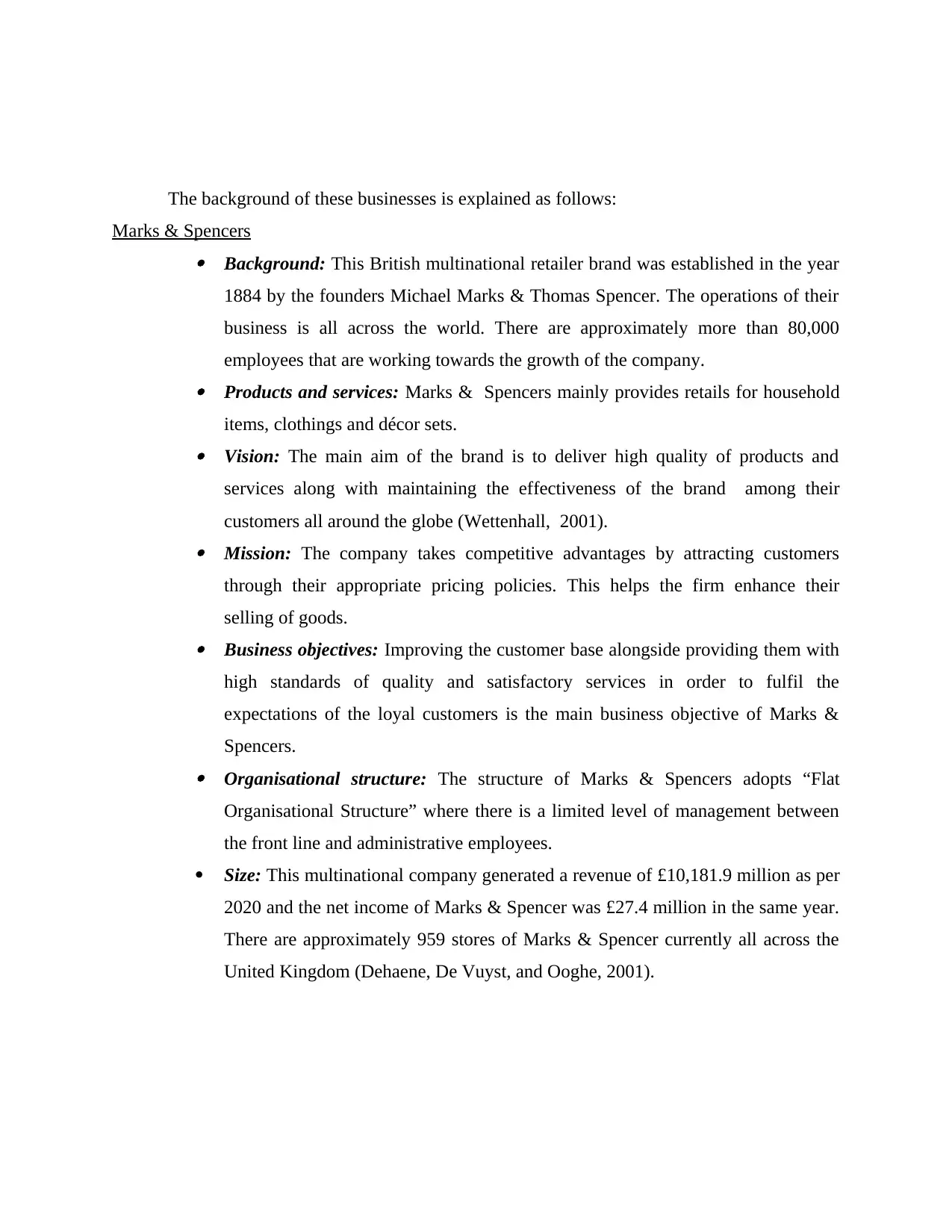
The background of these businesses is explained as follows:
Marks & Spencers
Background: This British multinational retailer brand was established in the year
1884 by the founders Michael Marks & Thomas Spencer. The operations of their
business is all across the world. There are approximately more than 80,000
employees that are working towards the growth of the company.
Products and services: Marks & Spencers mainly provides retails for household
items, clothings and décor sets.
Vision: The main aim of the brand is to deliver high quality of products and
services along with maintaining the effectiveness of the brand among their
customers all around the globe (Wettenhall, 2001).
Mission: The company takes competitive advantages by attracting customers
through their appropriate pricing policies. This helps the firm enhance their
selling of goods.
Business objectives: Improving the customer base alongside providing them with
high standards of quality and satisfactory services in order to fulfil the
expectations of the loyal customers is the main business objective of Marks &
Spencers.
Organisational structure: The structure of Marks & Spencers adopts “Flat
Organisational Structure” where there is a limited level of management between
the front line and administrative employees.
Size: This multinational company generated a revenue of £10,181.9 million as per
2020 and the net income of Marks & Spencer was £27.4 million in the same year.
There are approximately 959 stores of Marks & Spencer currently all across the
United Kingdom (Dehaene, De Vuyst, and Ooghe, 2001).
Marks & Spencers
Background: This British multinational retailer brand was established in the year
1884 by the founders Michael Marks & Thomas Spencer. The operations of their
business is all across the world. There are approximately more than 80,000
employees that are working towards the growth of the company.
Products and services: Marks & Spencers mainly provides retails for household
items, clothings and décor sets.
Vision: The main aim of the brand is to deliver high quality of products and
services along with maintaining the effectiveness of the brand among their
customers all around the globe (Wettenhall, 2001).
Mission: The company takes competitive advantages by attracting customers
through their appropriate pricing policies. This helps the firm enhance their
selling of goods.
Business objectives: Improving the customer base alongside providing them with
high standards of quality and satisfactory services in order to fulfil the
expectations of the loyal customers is the main business objective of Marks &
Spencers.
Organisational structure: The structure of Marks & Spencers adopts “Flat
Organisational Structure” where there is a limited level of management between
the front line and administrative employees.
Size: This multinational company generated a revenue of £10,181.9 million as per
2020 and the net income of Marks & Spencer was £27.4 million in the same year.
There are approximately 959 stores of Marks & Spencer currently all across the
United Kingdom (Dehaene, De Vuyst, and Ooghe, 2001).
Paraphrase This Document
Need a fresh take? Get an instant paraphrase of this document with our AI Paraphraser
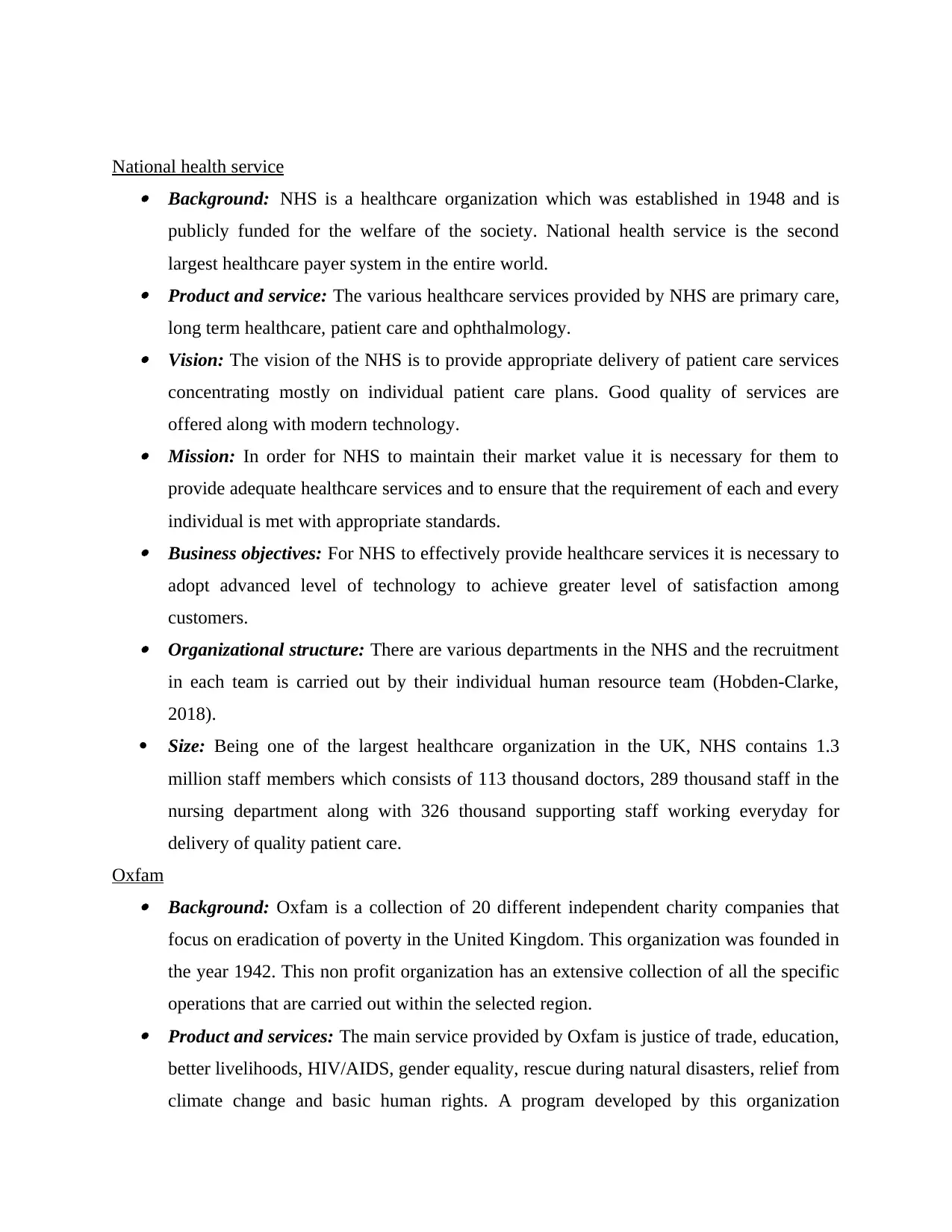
National health service Background: NHS is a healthcare organization which was established in 1948 and is
publicly funded for the welfare of the society. National health service is the second
largest healthcare payer system in the entire world. Product and service: The various healthcare services provided by NHS are primary care,
long term healthcare, patient care and ophthalmology. Vision: The vision of the NHS is to provide appropriate delivery of patient care services
concentrating mostly on individual patient care plans. Good quality of services are
offered along with modern technology. Mission: In order for NHS to maintain their market value it is necessary for them to
provide adequate healthcare services and to ensure that the requirement of each and every
individual is met with appropriate standards. Business objectives: For NHS to effectively provide healthcare services it is necessary to
adopt advanced level of technology to achieve greater level of satisfaction among
customers. Organizational structure: There are various departments in the NHS and the recruitment
in each team is carried out by their individual human resource team (Hobden-Clarke,
2018).
Size: Being one of the largest healthcare organization in the UK, NHS contains 1.3
million staff members which consists of 113 thousand doctors, 289 thousand staff in the
nursing department along with 326 thousand supporting staff working everyday for
delivery of quality patient care.
Oxfam Background: Oxfam is a collection of 20 different independent charity companies that
focus on eradication of poverty in the United Kingdom. This organization was founded in
the year 1942. This non profit organization has an extensive collection of all the specific
operations that are carried out within the selected region. Product and services: The main service provided by Oxfam is justice of trade, education,
better livelihoods, HIV/AIDS, gender equality, rescue during natural disasters, relief from
climate change and basic human rights. A program developed by this organization
publicly funded for the welfare of the society. National health service is the second
largest healthcare payer system in the entire world. Product and service: The various healthcare services provided by NHS are primary care,
long term healthcare, patient care and ophthalmology. Vision: The vision of the NHS is to provide appropriate delivery of patient care services
concentrating mostly on individual patient care plans. Good quality of services are
offered along with modern technology. Mission: In order for NHS to maintain their market value it is necessary for them to
provide adequate healthcare services and to ensure that the requirement of each and every
individual is met with appropriate standards. Business objectives: For NHS to effectively provide healthcare services it is necessary to
adopt advanced level of technology to achieve greater level of satisfaction among
customers. Organizational structure: There are various departments in the NHS and the recruitment
in each team is carried out by their individual human resource team (Hobden-Clarke,
2018).
Size: Being one of the largest healthcare organization in the UK, NHS contains 1.3
million staff members which consists of 113 thousand doctors, 289 thousand staff in the
nursing department along with 326 thousand supporting staff working everyday for
delivery of quality patient care.
Oxfam Background: Oxfam is a collection of 20 different independent charity companies that
focus on eradication of poverty in the United Kingdom. This organization was founded in
the year 1942. This non profit organization has an extensive collection of all the specific
operations that are carried out within the selected region. Product and services: The main service provided by Oxfam is justice of trade, education,
better livelihoods, HIV/AIDS, gender equality, rescue during natural disasters, relief from
climate change and basic human rights. A program developed by this organization
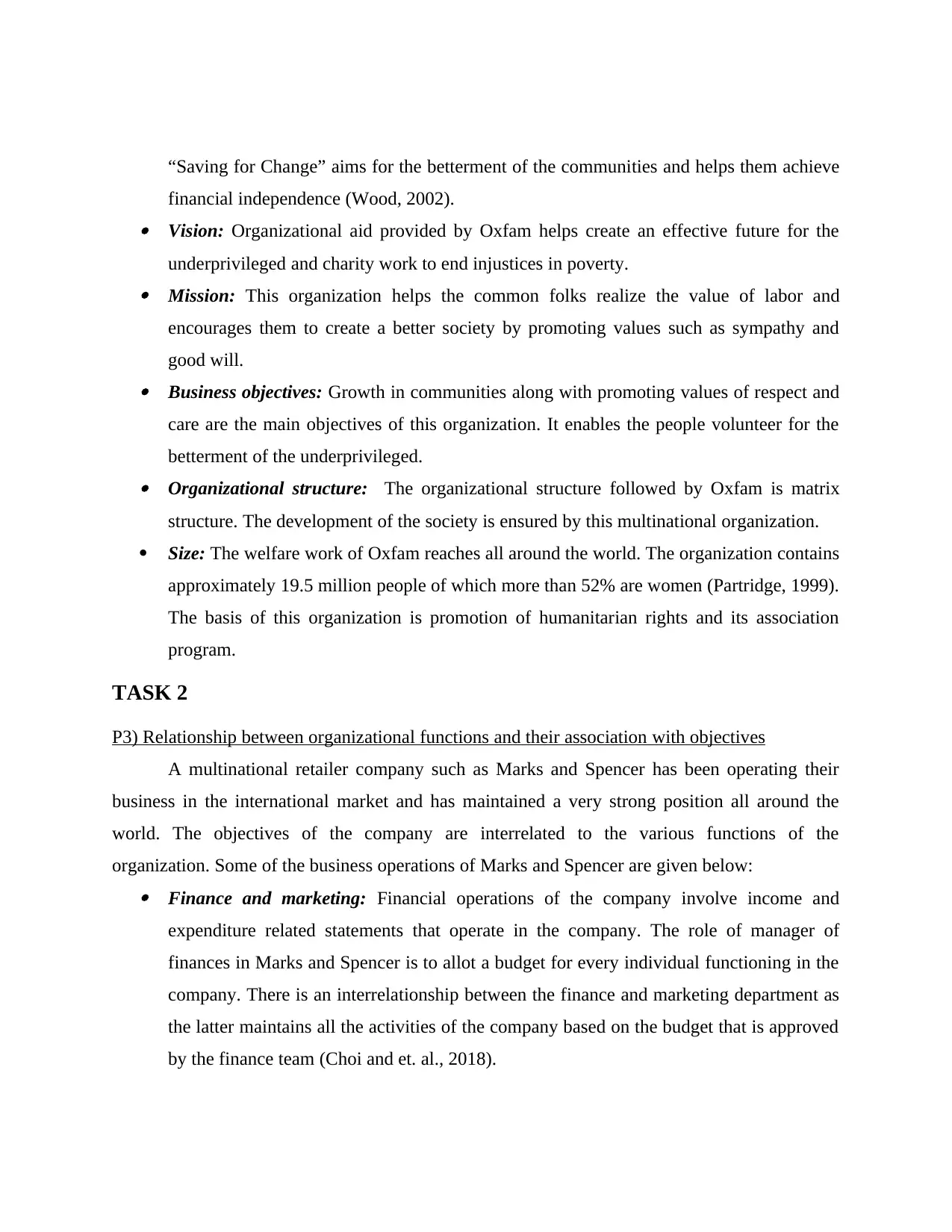
“Saving for Change” aims for the betterment of the communities and helps them achieve
financial independence (Wood, 2002). Vision: Organizational aid provided by Oxfam helps create an effective future for the
underprivileged and charity work to end injustices in poverty. Mission: This organization helps the common folks realize the value of labor and
encourages them to create a better society by promoting values such as sympathy and
good will. Business objectives: Growth in communities along with promoting values of respect and
care are the main objectives of this organization. It enables the people volunteer for the
betterment of the underprivileged. Organizational structure: The organizational structure followed by Oxfam is matrix
structure. The development of the society is ensured by this multinational organization.
Size: The welfare work of Oxfam reaches all around the world. The organization contains
approximately 19.5 million people of which more than 52% are women (Partridge, 1999).
The basis of this organization is promotion of humanitarian rights and its association
program.
TASK 2
P3) Relationship between organizational functions and their association with objectives
A multinational retailer company such as Marks and Spencer has been operating their
business in the international market and has maintained a very strong position all around the
world. The objectives of the company are interrelated to the various functions of the
organization. Some of the business operations of Marks and Spencer are given below: Finance and marketing: Financial operations of the company involve income and
expenditure related statements that operate in the company. The role of manager of
finances in Marks and Spencer is to allot a budget for every individual functioning in the
company. There is an interrelationship between the finance and marketing department as
the latter maintains all the activities of the company based on the budget that is approved
by the finance team (Choi and et. al., 2018).
financial independence (Wood, 2002). Vision: Organizational aid provided by Oxfam helps create an effective future for the
underprivileged and charity work to end injustices in poverty. Mission: This organization helps the common folks realize the value of labor and
encourages them to create a better society by promoting values such as sympathy and
good will. Business objectives: Growth in communities along with promoting values of respect and
care are the main objectives of this organization. It enables the people volunteer for the
betterment of the underprivileged. Organizational structure: The organizational structure followed by Oxfam is matrix
structure. The development of the society is ensured by this multinational organization.
Size: The welfare work of Oxfam reaches all around the world. The organization contains
approximately 19.5 million people of which more than 52% are women (Partridge, 1999).
The basis of this organization is promotion of humanitarian rights and its association
program.
TASK 2
P3) Relationship between organizational functions and their association with objectives
A multinational retailer company such as Marks and Spencer has been operating their
business in the international market and has maintained a very strong position all around the
world. The objectives of the company are interrelated to the various functions of the
organization. Some of the business operations of Marks and Spencer are given below: Finance and marketing: Financial operations of the company involve income and
expenditure related statements that operate in the company. The role of manager of
finances in Marks and Spencer is to allot a budget for every individual functioning in the
company. There is an interrelationship between the finance and marketing department as
the latter maintains all the activities of the company based on the budget that is approved
by the finance team (Choi and et. al., 2018).
⊘ This is a preview!⊘
Do you want full access?
Subscribe today to unlock all pages.

Trusted by 1+ million students worldwide
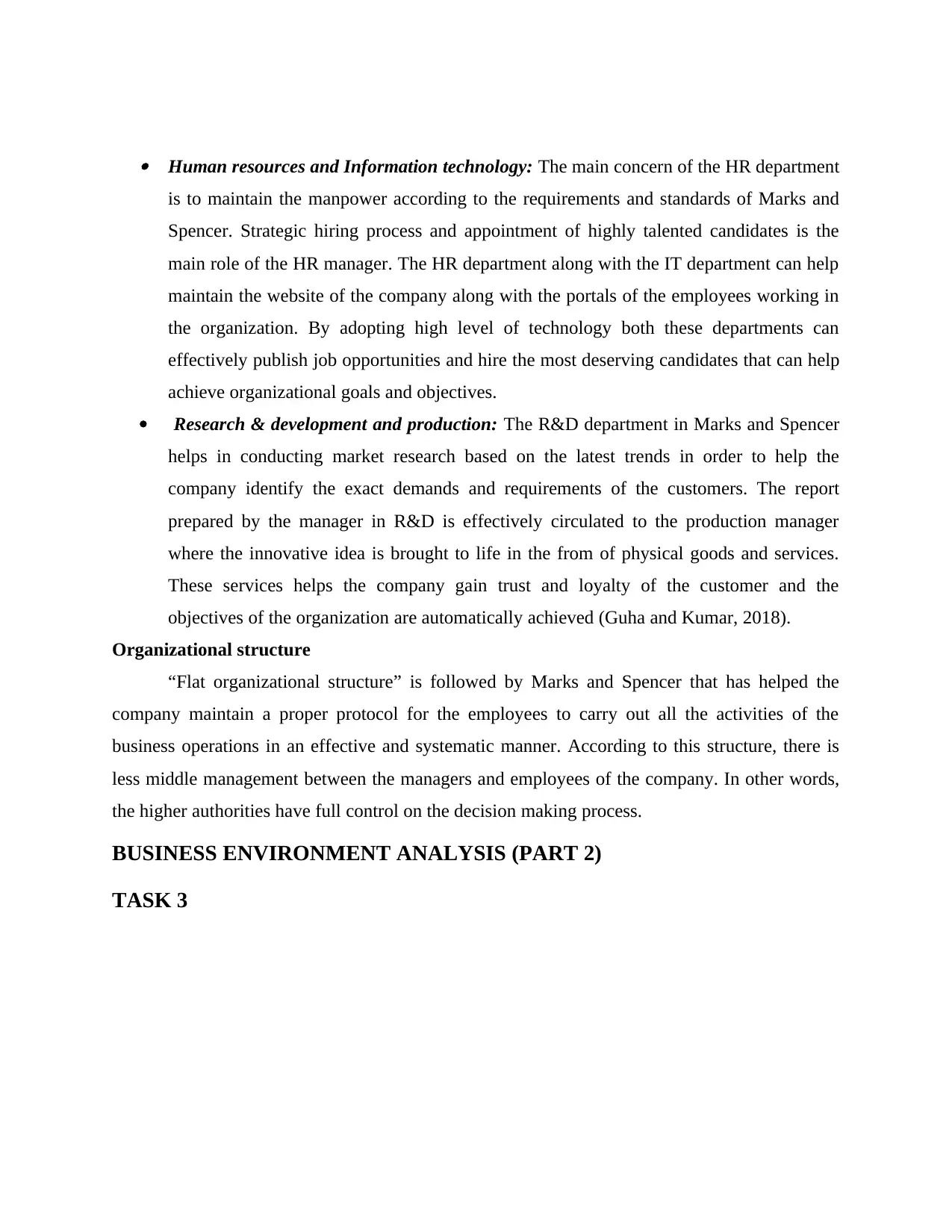
Human resources and Information technology: The main concern of the HR department
is to maintain the manpower according to the requirements and standards of Marks and
Spencer. Strategic hiring process and appointment of highly talented candidates is the
main role of the HR manager. The HR department along with the IT department can help
maintain the website of the company along with the portals of the employees working in
the organization. By adopting high level of technology both these departments can
effectively publish job opportunities and hire the most deserving candidates that can help
achieve organizational goals and objectives.
Research & development and production: The R&D department in Marks and Spencer
helps in conducting market research based on the latest trends in order to help the
company identify the exact demands and requirements of the customers. The report
prepared by the manager in R&D is effectively circulated to the production manager
where the innovative idea is brought to life in the from of physical goods and services.
These services helps the company gain trust and loyalty of the customer and the
objectives of the organization are automatically achieved (Guha and Kumar, 2018).
Organizational structure
“Flat organizational structure” is followed by Marks and Spencer that has helped the
company maintain a proper protocol for the employees to carry out all the activities of the
business operations in an effective and systematic manner. According to this structure, there is
less middle management between the managers and employees of the company. In other words,
the higher authorities have full control on the decision making process.
BUSINESS ENVIRONMENT ANALYSIS (PART 2)
TASK 3
is to maintain the manpower according to the requirements and standards of Marks and
Spencer. Strategic hiring process and appointment of highly talented candidates is the
main role of the HR manager. The HR department along with the IT department can help
maintain the website of the company along with the portals of the employees working in
the organization. By adopting high level of technology both these departments can
effectively publish job opportunities and hire the most deserving candidates that can help
achieve organizational goals and objectives.
Research & development and production: The R&D department in Marks and Spencer
helps in conducting market research based on the latest trends in order to help the
company identify the exact demands and requirements of the customers. The report
prepared by the manager in R&D is effectively circulated to the production manager
where the innovative idea is brought to life in the from of physical goods and services.
These services helps the company gain trust and loyalty of the customer and the
objectives of the organization are automatically achieved (Guha and Kumar, 2018).
Organizational structure
“Flat organizational structure” is followed by Marks and Spencer that has helped the
company maintain a proper protocol for the employees to carry out all the activities of the
business operations in an effective and systematic manner. According to this structure, there is
less middle management between the managers and employees of the company. In other words,
the higher authorities have full control on the decision making process.
BUSINESS ENVIRONMENT ANALYSIS (PART 2)
TASK 3
Paraphrase This Document
Need a fresh take? Get an instant paraphrase of this document with our AI Paraphraser
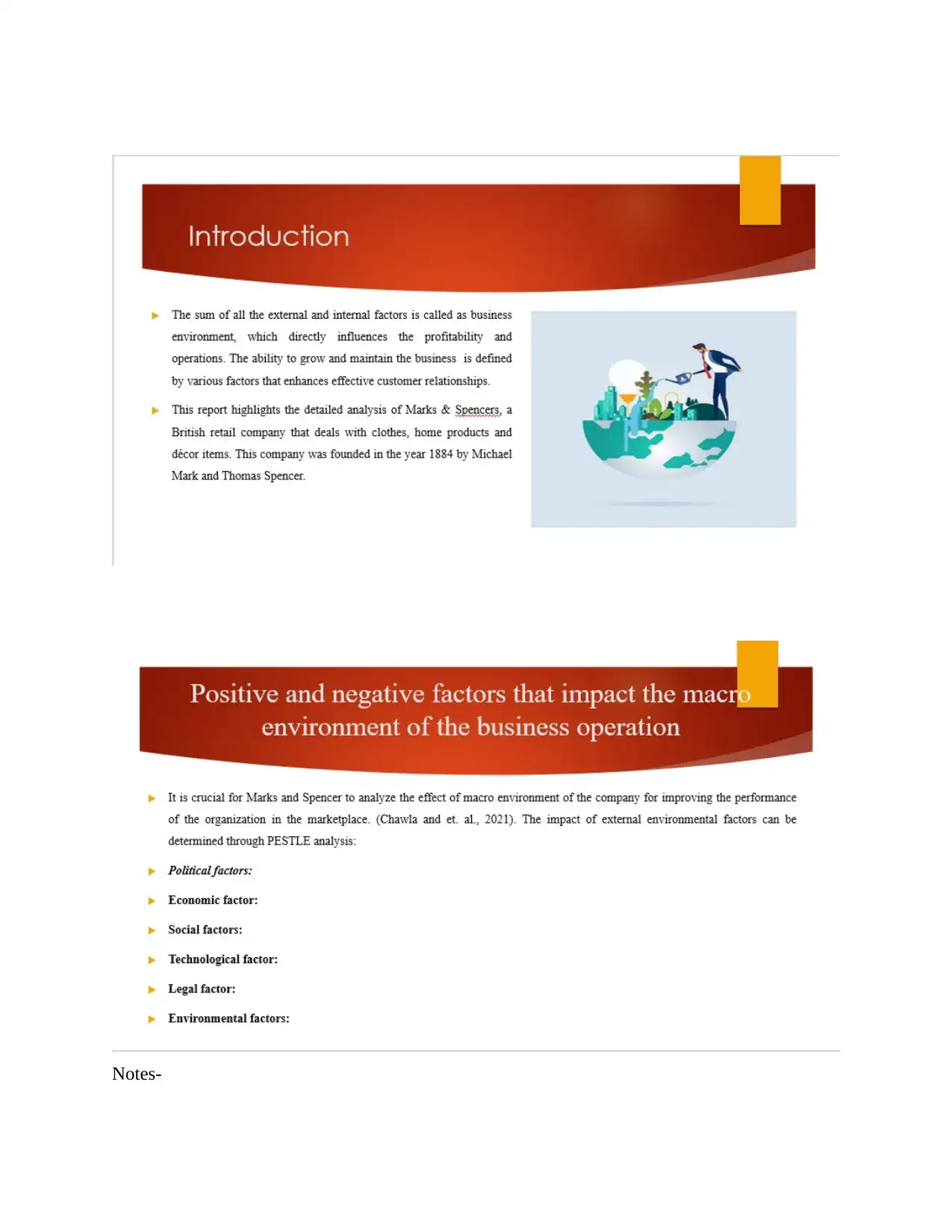
Notes-
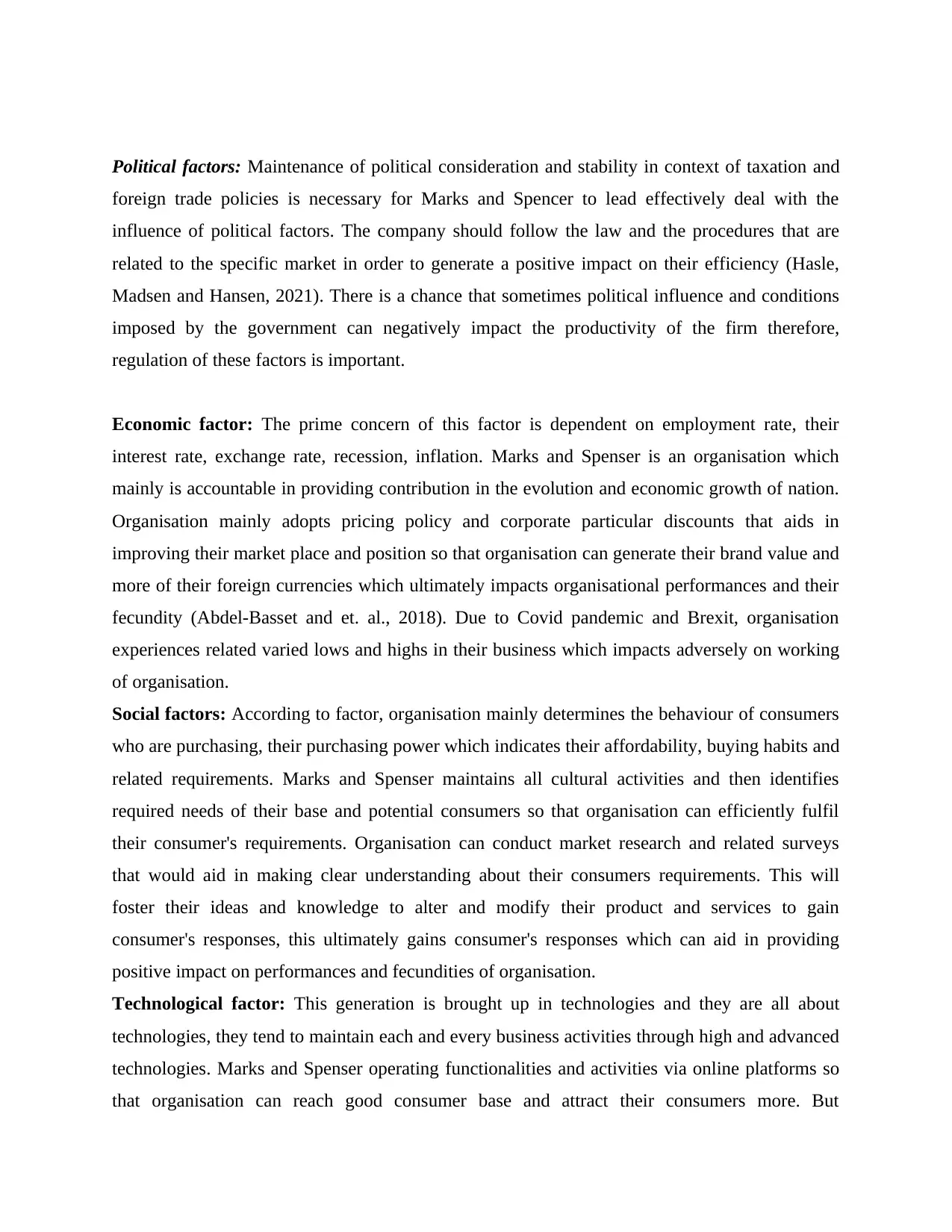
Political factors: Maintenance of political consideration and stability in context of taxation and
foreign trade policies is necessary for Marks and Spencer to lead effectively deal with the
influence of political factors. The company should follow the law and the procedures that are
related to the specific market in order to generate a positive impact on their efficiency (Hasle,
Madsen and Hansen, 2021). There is a chance that sometimes political influence and conditions
imposed by the government can negatively impact the productivity of the firm therefore,
regulation of these factors is important.
Economic factor: The prime concern of this factor is dependent on employment rate, their
interest rate, exchange rate, recession, inflation. Marks and Spenser is an organisation which
mainly is accountable in providing contribution in the evolution and economic growth of nation.
Organisation mainly adopts pricing policy and corporate particular discounts that aids in
improving their market place and position so that organisation can generate their brand value and
more of their foreign currencies which ultimately impacts organisational performances and their
fecundity (Abdel-Basset and et. al., 2018). Due to Covid pandemic and Brexit, organisation
experiences related varied lows and highs in their business which impacts adversely on working
of organisation.
Social factors: According to factor, organisation mainly determines the behaviour of consumers
who are purchasing, their purchasing power which indicates their affordability, buying habits and
related requirements. Marks and Spenser maintains all cultural activities and then identifies
required needs of their base and potential consumers so that organisation can efficiently fulfil
their consumer's requirements. Organisation can conduct market research and related surveys
that would aid in making clear understanding about their consumers requirements. This will
foster their ideas and knowledge to alter and modify their product and services to gain
consumer's responses, this ultimately gains consumer's responses which can aid in providing
positive impact on performances and fecundities of organisation.
Technological factor: This generation is brought up in technologies and they are all about
technologies, they tend to maintain each and every business activities through high and advanced
technologies. Marks and Spenser operating functionalities and activities via online platforms so
that organisation can reach good consumer base and attract their consumers more. But
foreign trade policies is necessary for Marks and Spencer to lead effectively deal with the
influence of political factors. The company should follow the law and the procedures that are
related to the specific market in order to generate a positive impact on their efficiency (Hasle,
Madsen and Hansen, 2021). There is a chance that sometimes political influence and conditions
imposed by the government can negatively impact the productivity of the firm therefore,
regulation of these factors is important.
Economic factor: The prime concern of this factor is dependent on employment rate, their
interest rate, exchange rate, recession, inflation. Marks and Spenser is an organisation which
mainly is accountable in providing contribution in the evolution and economic growth of nation.
Organisation mainly adopts pricing policy and corporate particular discounts that aids in
improving their market place and position so that organisation can generate their brand value and
more of their foreign currencies which ultimately impacts organisational performances and their
fecundity (Abdel-Basset and et. al., 2018). Due to Covid pandemic and Brexit, organisation
experiences related varied lows and highs in their business which impacts adversely on working
of organisation.
Social factors: According to factor, organisation mainly determines the behaviour of consumers
who are purchasing, their purchasing power which indicates their affordability, buying habits and
related requirements. Marks and Spenser maintains all cultural activities and then identifies
required needs of their base and potential consumers so that organisation can efficiently fulfil
their consumer's requirements. Organisation can conduct market research and related surveys
that would aid in making clear understanding about their consumers requirements. This will
foster their ideas and knowledge to alter and modify their product and services to gain
consumer's responses, this ultimately gains consumer's responses which can aid in providing
positive impact on performances and fecundities of organisation.
Technological factor: This generation is brought up in technologies and they are all about
technologies, they tend to maintain each and every business activities through high and advanced
technologies. Marks and Spenser operating functionalities and activities via online platforms so
that organisation can reach good consumer base and attract their consumers more. But
⊘ This is a preview!⊘
Do you want full access?
Subscribe today to unlock all pages.

Trusted by 1+ million students worldwide
1 out of 21
Related Documents
Your All-in-One AI-Powered Toolkit for Academic Success.
+13062052269
info@desklib.com
Available 24*7 on WhatsApp / Email
![[object Object]](/_next/static/media/star-bottom.7253800d.svg)
Unlock your academic potential
Copyright © 2020–2025 A2Z Services. All Rights Reserved. Developed and managed by ZUCOL.





